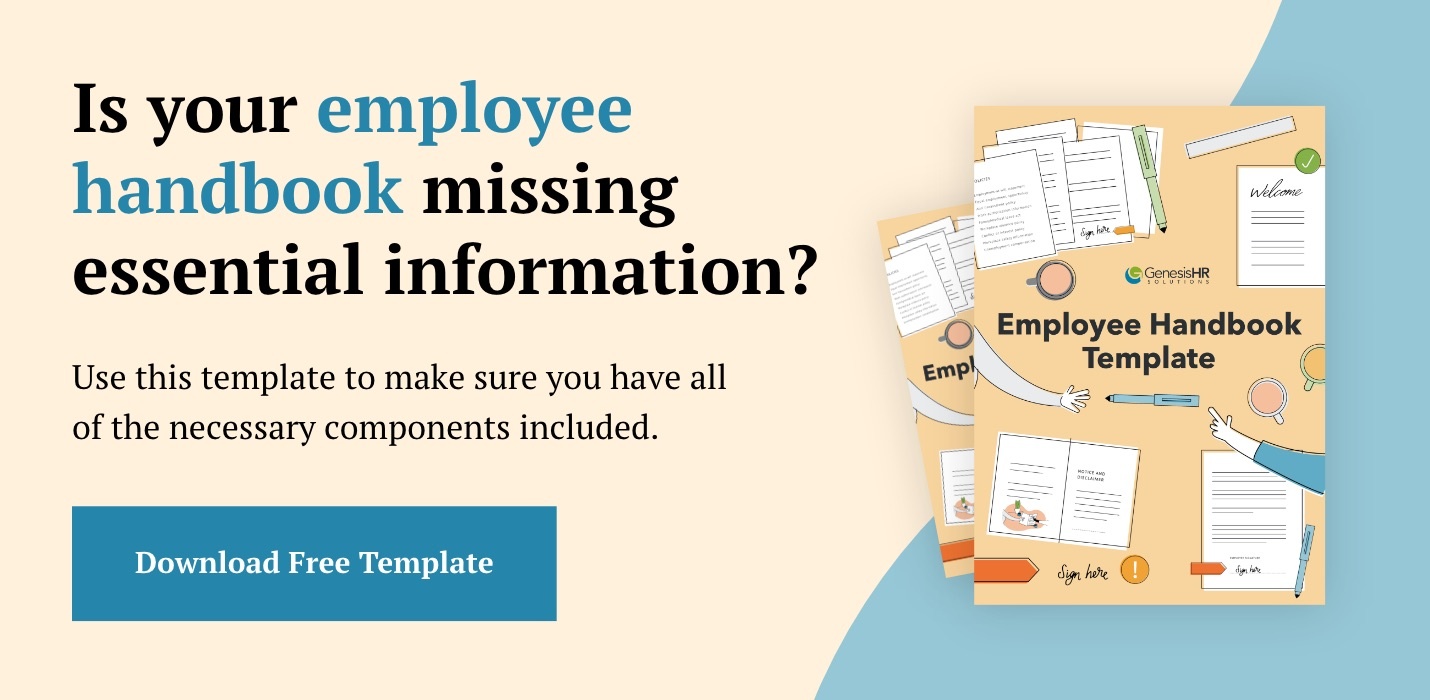Most employers know that having streamlined policies and procedures in place is a must for operating a successful business. Unfortunately, many companies are not organized when it comes to physically compiling their documentation in one central location—and as a result, their policies and procedures are ignored or not even known to their entire team.
This is a scary prospect, because in order to have a successful company, you must have a “home base,” so to speak, for where your policies and procedures live, so everyone in the organization can know where to find them. We call this home base an employee handbook. A handbook documents your organizational policies and procedures and any other need-to-know information for your employees. Handbooks help manage your employees’ expectations and keep your business compliant with the ever-growing list of employment rules and regulations.
But what differentiates a good employee handbook from one that sits in a filing cabinet and collects dust? It has to be a living document that truly reflects and guides the processes and activities of the employees who use it. An out-of-date employee handbook, or one missing key elements, is just as bad as not having one at all.
An out-of-date employee handbook, or one missing key elements, is just as bad as not having one at all. Share on XWhether you’re writing a handbook for the first time or want to verify the content of your existing handbook, the free non profit employee handbook template provided below will prove useful. It outlines all the employee handbook essentials, and includes optional components to consider. If you’re taking the time to write or rewrite your handbook, you might as well make it as robust and thorough as you can! This template is ideal for all organizations, and can even be used as the basis for creating a non-profit employee handbook.
Does your existing non profit employee handbook follow best practices? Download this free template to find out what it might be missing.
Keep reading to learn four best practices to consider when drafting or updating your handbook.
Best Practices For Drafting Non Profit Employee Handbooks
1. Be comprehensive.
Simply having an employee handbook is not enough. An out-of-date handbook, or one missing key elements, is just as bad as having none at all. Your handbook should include the following 17 items:
- Notice and disclaimer / Acknowledgement of Receipt
- Employment at-will policy
- Equal opportunity statement and anti-harassment statement
- Work authorization
- Policy on employment classification
- Overtime
- Leaves of absence
- Parental leave
- Workplace violence and workplace safety
- Conflict of interest
- Code of conduct
- Unemployment compensation
- Payroll deductions
- Direct deposit
- Holidays and other time off
- Health and welfare benefits and insurance
- Employee assistance
2. Be clear.
Poorly drafted non-profit employee handbooks can create confusion and introduce unintended liabilities for the employer. We’ve seen disgruntled employees point to confusing, vague, or contradictory language in employee handbooks as a reason or excuse for behavior; unfortunately for employers, if their handbooks don’t stand up to scrutiny, the employee will be deemed right. Organization leaders and HR teams should know what their handbooks say and be willing to stand by and back up the information when challenged.
3. Update it frequently.
Even the most eloquent, clear, and useful handbook is worthless if it’s outdated or no longer addresses current employee and employer issues. While there’s no set-in-stone timetable for updates, we recommend checking in every six months to make sure all elements of your handbook are still relevant. Especially in light of the COVID-19 pandemic, employers should be evaluating their handbooks and addressing remote work policies, furloughs, and emergency planning. Employees should re-sign the employee handbook each time it is updated.
Stay ahead of ever-changing laws with Genesis
One pitfall many non-profit organizations face is dealing with unintended liabilities introduced in outdated handbooks. As laws change (and they are constantly changing), Genesis works with our clients to update all information pertinent to them—including the information in their employee handbooks.
We’ll help you understand what’s changing and then assist you in updating policy language or creating new language if necessary, so you don’t have to spend your time playing catch-up.
4. Don’t over-complicate it.
While your employee handbook serves as legal clarification of your policies and procedures, it should primarily be an educational and inspiring document. It’s fine to include disclaimers to clarify the handbook’s purpose, but in general the language you use should be less formal—not legalese—and speak to the culture and vibe of your company.
Write it down—then follow the policies set forth.
Your employee handbook will never be “done.” In fact, to be effective, your employee handbook should be a living document that is used, questioned, and reviewed on a regular basis. Only once your organization sees the handbook as an HR bedrock will it be useful, so be as comprehensive as possible—and then get everyone on the team reading it!




